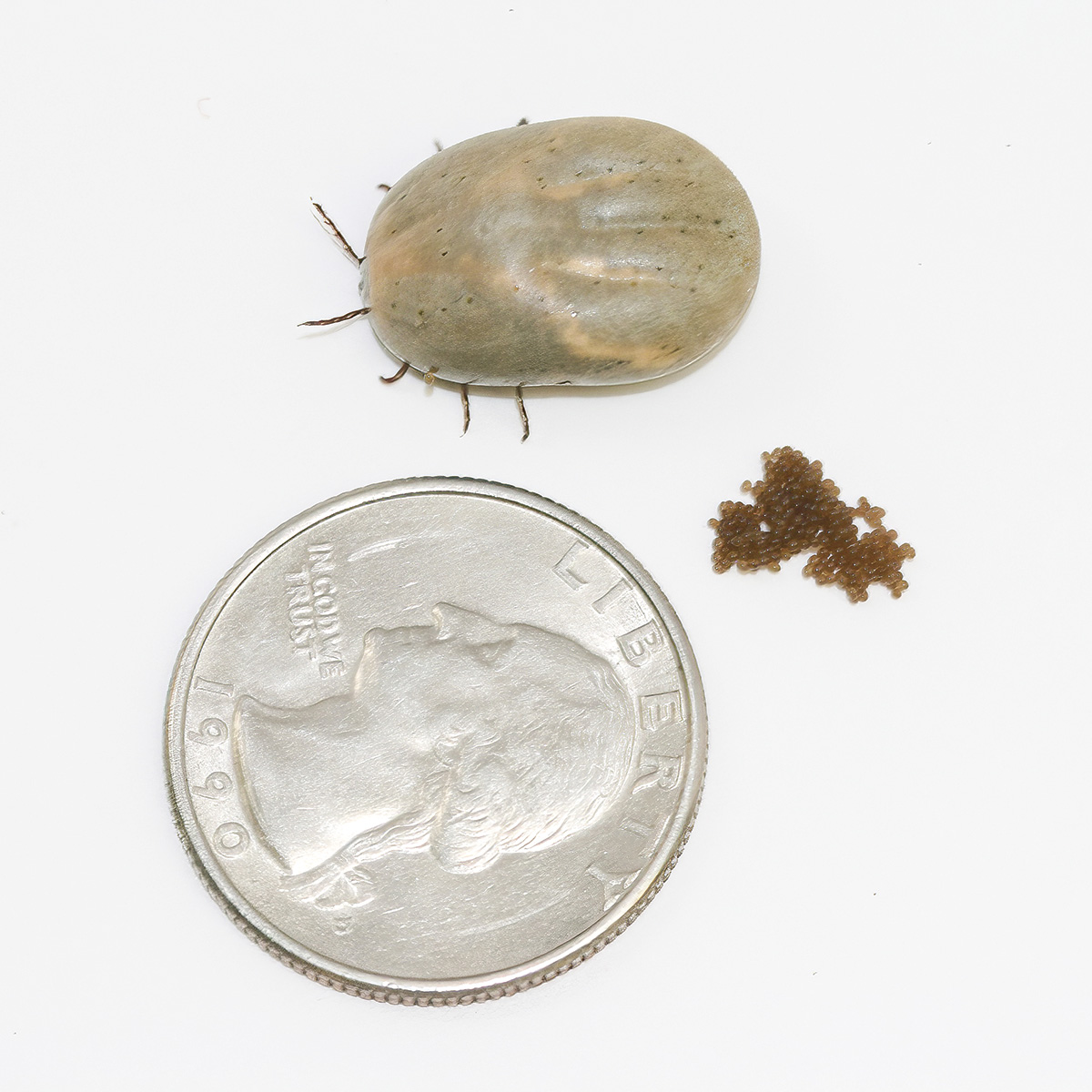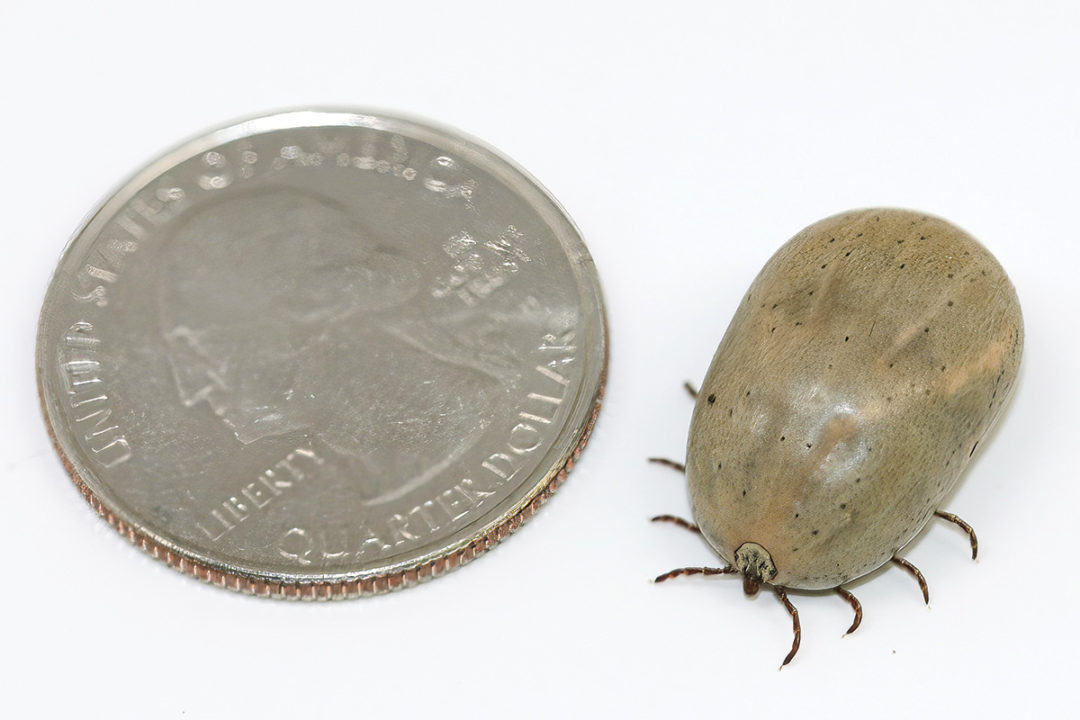Ticks are ectoparasitic arachnids and feed exclusively on blood meals from several different hosts as their life cycle progresses. Hosts can include birds, amphibians, reptiles and often mammals. Ticks have the ability to transmit numerous blood-borne pathogens that may affect host species, making them an important vector for livestock and other animals in Idaho.
They have four life stages: egg, larva, nymph and adult. They must have an appropriate blood meal from a host and molt in order to progress to their next life stage. Individual tick eggs are very hard to see with the naked eye, though they are usually opaque brown and are laid on the soil in large bunches (hundreds to thousands) by the females in the spring. Eggs hatch from spring to summer into six-legged larvae and after a blood meal molt into eight-legged nymphs.
Adult ticks have functioning reproductive organs and, unlike mosquitoes, both the females and males feed on blood meals. Interestingly, the life cycle can take anywhere from two to three years to complete depending upon the local climate, the abundance of hosts and numerous other biotic/abiotic factors. Fully engorged female ticks may be about the size of a standard U.S. quarter, with the abdomen completely filled with eggs. Ticks are generally divided into two main groups, the hard ticks (family: ixodidae) and soft ticks (family: argasidae), respectively. The majority of the 1,000 species of ticks on Earth and in Idaho are in the hard tick grouping.
Tick behavior
Tick behavior and feeding are well-studied within the scientific literature. Ticks can find hosts by detecting body odor/heat, moisture, vibrations or chemistry (specifically sensing carbon dioxide). Ticks don’t jump, fall or fly onto their animal hosts, instead they typically lie in wait on vegetation and exhibit a well-known behavior called questing. Questing involves attaching their third and fourth pair of legs to the vegetation and “waving” around their first and second pair of legs, trying to cling on to a host passing by. Depending upon the life stage, the questing height on the vegetation is directly correlated to the host size. Tick larvae and nymphs tend to feed on smaller hosts early in their life stage; as adults they seek out larger hosts. After locating a host, ticks may wander on the host for 10 minutes to two hours, looking for a spot to insert their mouthparts.
Ticks cut a hole into the epidermis of the host and insert the mouthparts (called a hypostome) along with saliva. Tick saliva can contain chemicals that can be anesthetic (numbing), anti-coagulant, inhibit platelets and secrete a cementlike substance to firmly attach and seal the mouthparts into the host, along with up to 3,000 different identified proteins.
In Idaho, most tick bites occur from May until September when the climate is warmer and hosts are actively foraging throughout our ecosystems.
Because ticks feed on blood, they may transmit several different pathogens to hosts and important animal species in Idaho. Pathogens can be numerous different biological types, including protozoa, rickettsia, bacterial or viral in nature. Important tick-human pathogens include Lyme disease, anaplasmosis, Rocky Mountain spotted fever and tularemia. If bitten by a tick and you suspect you may be ill, please contact your local healthcare provider immediately. Important tick livestock pathogens include tuberculosis, brucellosis, anaplasmosis, bovine spongiform encephalopathy (BSE), cattle fever tick, Colorado tick fever and foreign animal disease (FAD). Livestock in Idaho, including birds, cattle/bison, horses, swine, sheep/goats and wildlife (deer/elk), can be potential hosts of ticks and associated pathogens. Tick feeding and vectoring of pathogens can result in livestock skin damage, weight loss, anemia, reduction of meat/milk production and sometimes death of the animal.

A fully engorged female tick (top) with a few dozen eggs (right) sits next to a standard U.S. quarter. Photo by Brad Stokes.
Prevention
Tick prevention starts with knowing your local environment and the grazing area for your livestock. Ticks are most commonly found in wooded areas or in high grasslands. Keeping your fencing away from wooded areas may reduce animal-to-tick contact. You can also chemically treat your wooded areas with acaricides to potentially reduce tick populations. However, using environmental management strategies is not always feasible for animal owners. Therefore, it is important to know the species of tick you are dealing with to implement the proper prevention techniques. In Idaho, the most common tick species are the American dog tick, Rocky Mountain wood tick, Western blacklegged tick (also called the deer tick) and the brown dog tick.
American dog ticks can find themselves in open fields, and are most known for transmitting Rocky Mountain spotted fever. Similarly, the Rocky Mountain wood tick can also be found from grassland areas to forest ecosystems. Both the American dog tick and Rocky Mountain wood tick transmit Rocky Mountain spotted fever; however, the wood tick can also transmit the Colorado tick fever virus. Livestock grazing pasture or rangeland are more likely to encounter the previously mentioned tick species. The Western blacklegged deer tick is found in forested areas with their main host being wild animals, such as deer, but if livestock are grazing in similar habitats, they can very easily become a host. Additionally, the deer tick is the only tick in Idaho that vectors Lyme disease.
Control methods
Generally, in Idaho, the use of chemical control methods may be the easiest approach for managing ticks for livestock. Chemical control methods include the use of ear tags, pour-ons, sprays, mists and dusts that contain pesticides or acaricides. Numerous active ingredients and various trade names are listed for control of ticks on livestock in Idaho. Dipping vats of acaricide baths are extremely effective but are not always practical. In large groups of cattle, the use of high-pressure sprayers may be the easiest, most effective chemical prevention method. Please be aware that the use of chemical control methods can increase pesticide resistance within the tick population. Therefore, it is important to always reapply on a routine basis and to alternate the modes of action with these chemicals to reduce the chances of pesticide resistance. It is always important to read and follow the pesticide label instructions and apply as directed.
Applying treatments early in the spring and continuing throughout the tick season can reduce tick numbers in highly infested areas. Integrating the combination of environmental and chemical prevention methods can reduce the need for chemical treatments and pesticide resistance.
Symptoms
Common tick/infection symptoms to look for in livestock include increased or labored breathing, lethargy, pale mucous membranes, cattle coming off feed, fever and (in extreme cases) death. If you suspect your cattle may be infected by a serious illness, contact your local veterinarian immediately. Reducing the amount of stress and movement placed on the specific animal of concern is also advisable.



.jpg?t=1687979285&width=640)


.jpg?height=auto&t=1713304395&width=285)


